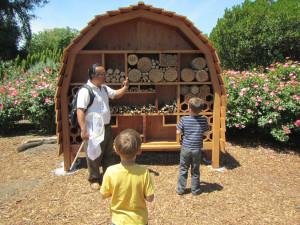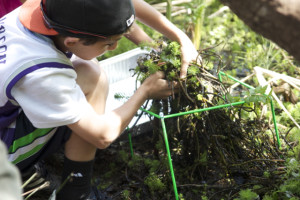“If you throw something on Foothill Boulevard, how does it end up in the Pacific Ocean?” asks Jonah Yamagata.
Hands shoot up. “The wind can blow it,” says Angel Gutierrez. “Into storm drains,” Timothy Courtney pipes up.
Yamagata nods. “And from there it goes into the creek and then to a large body that looks like a mermaid from outer space . . . who can tell me what that is called?” All kids call in unison: “The San Francisco Bay!”
This is Rebecca Schramm’s third-grade class at East Oakland’s Cox Academy. Yamagata is an instructor with Kids for the Bay, a nonprofit that provides science and environmental education programs to low-income East Bay schools. But there’s a twist to the curriculum: A core concept is environmental justice, with a focus on the dangers of eating Bay-caught fish, which often make up part of the diet for immigrant families here.
Schramm says that even though the kids are often still learning English, they get it. “The feedback often comes the next day,” she says. “We’ll be lining up on the playground, and someone will see a stray candy wrapper and ask to remove it before it goes into a storm drain.”
The Kids for the Bay definition of pollution is broader than stray candy wrappers. Instructors use a map to show 37 Superfund sites around the Bay, and they explain how six active oil refineries make Contra Costa the country’s second most industrialized county.
All that industry means lots of pollutants. Take polychlorinated biphenyls (PCBs): Linked to cancer and other ailments, they still persist in the Bay long after they were phased out in 1979. Mercury, from both present-day industry and old mining runoff, also accumulates in fish and can affect brain development in people.
A 2011 survey by the state Water Resources Control Board showed eight of California’s 42 most popular fishing areas were so contaminated that fish caught there were “inedibly toxic.”
“I hate to suggest an outright ban on eating fish,” says Dick Jackson, chair of the University of California, Los Angeles Environmental Health Sciences department. “Traditionally it is poor people who fish in San Francisco Bay–meeting recreational and nutritional needs at the same time.”
Torm Nompraseurt knows this firsthand. One of the first Laotians to settle in Contra Costa in 1975, he now serves as a policy advocate at the Asian Pacific Environmental Network. “For Laotians, fishing is not just a sport,” he says. “It is to feed family. People always want to bring a big fish home. But here in the Bay Area, bigger fish means more accumulation, more problems.”
In the mid-90s, Nompraseurt’s group ran “toxic tours,” combining human anatomy lessons with neighborhood walkabouts. The results were mixed, Nompraseurt reports: “Some believed, some didn’t. Some believed for a while.”
Kids for the Bay aims to speed up and strengthen community awareness by starting young. The program’s curriculum begins by showing kids a view of San Francisco Bay from space. Coming down to earth, the class goes on a field trip to the Berkeley pier, where students pool their collective language ability to interview anglers. They also survey their own families’ fishing habits. Finally, at the end of the sessions, students take a turn at teaching. At a school open house, they don aprons and demonstrate safe practices–filleting fish to avoid more-toxic organs and eating sea-dwellers like brown rockfish.
At a fifth-grade class at Franklin Elementary near Lake Merritt, Kids for the Bay instructor Deborah Zierten distributes tubs of crabs and striped bass.
A girl holds up her fish and plays with its tail. “Look, it’s like Finding Nemo !” Another gags as she prods the crab in her tray.
“Remember,” says Zierten, “scientists don’t say ‘ugh.’ Who can tell me if they have a male or a female crab ” Hands shoot up. One student, pointing to his crab’s abdomen, calls out, “I did this in third grade. If this thingamabob is longer or shorter you can tell that it is a male or a female.”
That kind of knowledge might come in handy when the kids interview anglers over the next few weeks. And when they grow up and start raising, and feeding, their own families.
Learn more at kidsforthebay.org.

.jpg)



